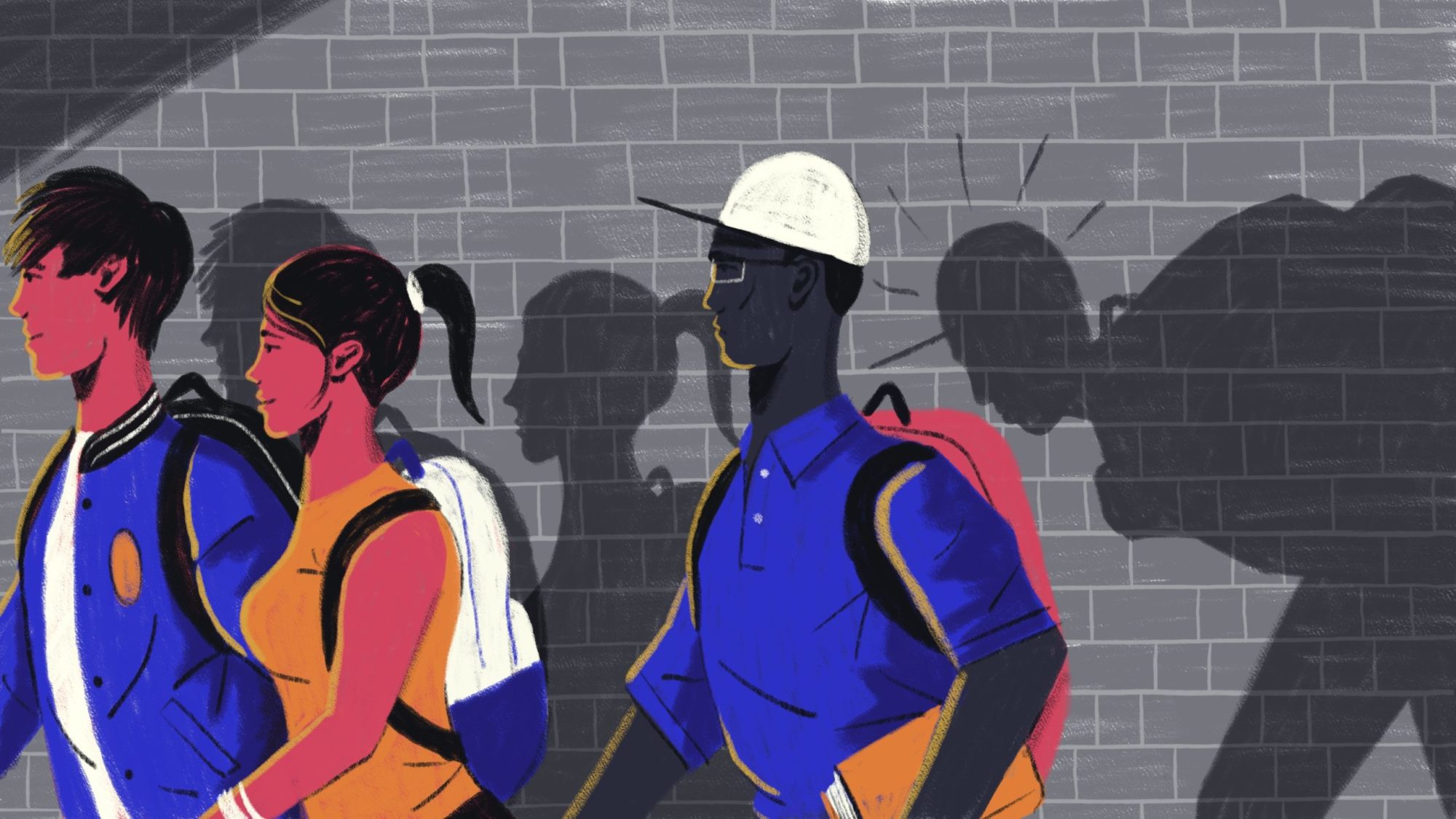Much about the world in 2020 has felt paralyzing: a global pandemic, unbridled state-sanctioned violence against Black bodies, unnatural disasters, a toxic political climate—all intersecting, overlapping, and wreaking havoc.1 As a social scientist, I can sometimes convince myself that I have little of real benefit to offer during these times. After all, I am neither a frontline worker nor a first responder. Yet for all its flaws, social science research can contribute to mitigating or repairing harm in the world. One way it can do so is by helping to deconstruct hierarchies in service of racial justice and on behalf of marginalized communities.
In an essay for last year’s Digest, I used Critical Race Theory (CRT) to reimagine the usefulness of research, positing that useful research evidence communicates the lived experiences of marginalized groups so that the understanding of the problem and its response is more likely to be impactful to the community in the ways the community itself would want” (Doucet, 2019). I also detailed three implications of CRT for improving the usefulness of research evidence, namely that more useful evidence centers a racial analysis of the usefulness of research for policy and practice; that the democratization of research production leads to more useful evidence; and that transdisciplinary approaches and methods can be leveraged to improve the usefulness of research. Whereas these ideas align with our call for studies that identify or test strategies for producing more useful research evidence, in this essay I turn to another facet of the Foundation’s broader focus on improving the use of research evidence: our interest in supporting studies that identify and test strategies to improve the use of existing research evidence in ways that benefit youth. Specifically, this essay is concerned with improving the use of evidence from antiracist research, which I define as: 1) race- and racism-conscious, 2) strengths-based, 3) humanizing, 4) co-constructed, and 5) community-centered.2
Adopting Critical Perspectives as a Rejection of Deficit Frames
To write about me
Because they never understand
Black love is Black wealth and they’ll
Probably talk about my hard childhood
And never understand that
All the while I was quite happy
—from “Nikki Rosa” (Giovanni, 1970).
The excerpts above, taken from the writings of Black women, represent counternarratives to the dominant, two-dimensional representations of Black life in academic and popular discourse.
In Nikki Rosa, the poet Nikki Giovanni recounts her childhood, fragments of memories, and experiences of everyday banalities and persistent hardships that weave the joys and pains of human existence. She acknowledges the narrow gaze of White interlocutors who “never talk about how happy you were … if you become famous or something,” ending with the lines of verse above to underline the point—“they never understand [that] Black love is Black wealth.”
Critical race theories lift the hood on research endeavors and point to the places where fundamental assumptions about research as objective, colorblind, neutral, and/or dispassionate serve to mask its potential to harm and to dehumanize
The second excerpt is from a narrative inquiry by four Black women scholars who grew up in East St. Louis, a city excoriated by famed educator and writer Jonathan Kozol in his best-selling book Savage Inequalities for its disinvestment in and underfunding of predominantly Black public schools. While the actions of policymakers and stakeholders in East St. Louis were shameful and Kozol’s exposition of their racism and neglect was effective, his chapter on East St. Louis concludes with such a tone of despair that one has to wonder why anyone would choose to live there: “East St. Louis will likely be left just as it is for a good many years to come: a scar of sorts, an ugly metaphor of filth and overspill and chemical effusions, a place for Blacks to live and die within, a place for other people to avoid when they are heading for St. Louis” (Kozol, 1991, p. 39). Missing from this account are residents’ agentic acts in the interests of their communities—their “ways of knowing and doing” (Farmer-Hinton et al., 2013, p. 8); teachers’ resolve in fighting for their students, holding them to high expectations of them, and pushing them to achieve; and families’ enduring resilience in the face of indifference, among other examples telling a parallel and far more self-determining story of East St. Louis. Moves such as Kozol’s—centering Black pain over joy and making a case for righting wrongs with sensational stories or shocking statistics—are well known in social science research, called out by scholars like Solórzano (1991) as deficit traditions, by Gutierrez and Orellana (2006) as “predictable genre(s)” of difference that locate “problems” in marginalized people or disenfranchised communities rather than in systems and structures that maintain power hierarchies, and by Tuck (2009) as “damage-centered research: research that operates, even benevolently, from a theory of change that establishes harm or injury in order to achieve reparation” (p. 414).
Using CRT and Yosso’s (2005) Community Cultural Wealth Model, Farmer-Hinton and colleagues speak back to Kozol through counternarratives imbued with themes of familial capital, aspirational capital, resistant capital, navigational capital, and social capital. Their narratives illuminate how a place like East St. Louis can be both a site that embodies the ugliness of this country’s racism and a site that births four Black woman Ph.D.s, thus interrupting Kozol’s “single story” (Adichie, 2009) and providing a richer, more complex, and nuanced view of the city and its inhabitants. Critical interrogations such as this illuminate the impact of single stories on real people’s lives, regardless of purported good intentions on the part of researchers. Critical race theories lift the hood on research endeavors and point to the places where fundamental assumptions about research as objective, colorblind, neutral, and/or dispassionate serve to mask its potential to harm and to dehumanize people who are Black, Indigenous, and People of Color (BIPOC), whether they are called “subjects” or “participants.” As Orellana and Gutierrez (2006) write: “We need to think carefully about the problems we name…Whose problem is it? For whom is it a problem? What other problems might we identify if we began from different vantage points” (p. 118).
Unless everyday people have a central role in telling their own stories, the stories researchers tell about their lives will always run the risk of glorifying dominant discourses—stereotypes, caricatures, incomplete stories
In my previous essay, I noted that, “As a human endeavor, research is inextricably implicated in the societal structures and systems that have served to maintain power hierarchies and accept social inequity as a given. Indeed, research has been historically and contemporaneously (mis)used to justify a range of social harms from enslavement, colonial conquest, and genocide, to high-stakes testing, disproportionality in child welfare services, and “broken windows” policing” (Doucet, 2019, p. 2). There is an African saying popularized by Zimbabwean doctor and writer J. Nozipo Maraire, “Until the lion learns to write, tales of hunting will always glorify the hunter” (1996, pp. 78-79). Nozipo continues, “So it is with life,” and I add, so it is with research. Unless everyday people have a central role in telling their own stories, the stories researchers tell about their lives will always run the risk of glorifying dominant discourses—stereotypes, caricatures, incomplete stories. Critical race theories disabuse us of notions that research is racemute, to adapt Pollock’s (2004) term, and help us to see how not questioning the assumptions and motivations that undergird the theories that frame our work, the people who conduct research, the questions we ask, the people we study and how we study them, and so on, all too easily results in research that reproduces old, tired, racist tropes (Solórzano & Yosso, 2001).
Applying Critical Race Theory and Imagining Antiracist Research
In David Kirkland’s essay for the 2019 Digest, he wrote that the primary locus of inquiry in the study of research use, and, I would add, in research production, are questions of how (e.g., methods) and what (e.g., “the problem”), and much less often deep excavations of why (why is this research being conducted? Why this finding?), by whom (whose knowledge is being centered?), and for whom (on whose behalf? who benefits?) research is used or produced (Kirkland, 2019). From a critical race perspective, I offer that antiracist research could be re-imagined to answer these questions toward more just ends. That is to say, critical race perspectives might answer the questions posed above like this:
- How should we do research? In race- and racism-conscious ways, wherein the questions, designs, participants, measures, analyses, and results refuse to be racemute and are interrogated through critical race lenses.
- What problems should we study? Those identified by, or at minimum in collaboration with, BIPOC communities, with attention to ensuring research questions are rooted in strengths-based framings of these communities, rather than supporting narratives that would deny or ignore community members’ agency or self-determination while framing researchers and decision makers as saviors.
- Why should the research be conducted? Contrary to research on BIPOC communities that assumes fundamental inferiorities (be they genetic, “cultural,” or otherwise) and paints caricatures, antiracist research aims to humanize research participants and their experiences. Antiracist research also resists the pull toward facile interpretation of findings that would reinforce racist ideas about BIPOC’s intelligence, parenting skills, proclivities toward violence, or mental health.
- By whom should the research be conducted? Research is a way of knowing that can be taught and that ought not be reified as precious and unattainable by “everyday people.” To be sure, learning the tools of research takes time, and the support of experienced researchers can bolster BIPOC communities’ efforts to systematically investigate issues of concern. As such, antiracist research is often co-constructed. This can range from direct collaboration, with BIPOC youth and families taking an active role in every phase of the research, to the process known as member checking, whereby research participants are consulted about researchers’ interpretation of research findings. Here the goal is to story with, not story about.
- For whom should the research be conducted? Or, more aptly, on whose behalf should research be conducted? Who should benefit from findings and subsequent decisions? In my previous essay, I argued unequivocally that marginalized communities should be the beneficiaries of research efforts and the responses that emerge from such efforts. As such, another marker of antiracist research is that it is community-centered. To the extent that practitioners, advocates, policymakers, and researchers operate in right relationship with communities, it is arguable that they would benefit from antiracist research as well.
Designing Studies to Improve the Use of Antiracist Research Evidence
What Do We Know About Getting Evidence Used?
Foundation grantee Itzhak Yanovitzky offers a broad framework summarizing the evidence on evidence use and arguing that stakeholders are more likely to engage with and use research evidence that is responsive, routinized, and relational (Yanovitzky, 2020; see also, e.g., Best & Holmes, 2010; Bogenschneider et al., 2019; Brown et al., 2016; Oliver et al., 2014). Responsive evidence is well-matched to what users need. It is timely, conveys useful information, is accessible in presentation for the target audience, and has actionable implications. Routinized evidence is incorporated into existing individual and organizational procedures such as workflows, routines, and decision making processes. Finally, evidence use is relational in that decision makers are more likely to use evidence when it comes from a trusted source. Below, I will propose possibilities for applying these principles to the use of antiracist research evidence. The important distinction here is that encouraging the use of evidence from antiracist research requires thinking differently about what is relevant, how antiracist perspectives are built into routines for using research, and what it means to build trusting relationships.
Additionally, I will provide examples of studies that might be conducted to build and test strategies to improve the use of evidence from antiracist research, defined here as: 1) Race- and racism-conscious; 2) Strengths-based; 3) Humanizing; 4) Co-constructed; and 5) People- and community-centered. These studies fall into two major categories: 1) studies on improving the use of co-produced antiracist research and 2) studies on improving the use of existing antiracist research.
While the criteria for antiracist research naturally extend from the qualities of useful evidence described above, it is possible (and likely) that additional strategies will be needed since antiracist frameworks and evidence might be new to decision makers. The creative possibilities make this an exciting new area for exploration, testing, and building.
Improving the Use of Co-Produced Antiracist Research
One of the Foundation’s long-standing interests has been whether the co-production of evidence deepens decision makers’ understanding of research evidence, thus making it more likely that they will consider research evidence in daily decisions and strategic planning (DuMont, 2016). In their study of the use of research evidence by child welfare evidence-based model developers, service providers, and agency staff, Metz and Barley (2017, p. 119) noted that stakeholders were more involved in research use when the research took their perspectives and needs into account and promoted systems thinking among stakeholders. In addition, they highlighted contextualization—adapting and tailoring evidence-based tools, protocols, and products for specific contexts—as another important condition to facilitate the use of research evidence by child welfare policymakers (Palinkas et al., 2014). To take this work to the next level, we need studies that center the needs of community members themselves (and to examine when, how, and why the needs that drive their use of evidence differs from those of decision makers) (Doucet, 2019), as well as more co-produced research that takes an explicit antiracist stance.
In last year’s essay, I discussed the democratization of research production as a mechanism for generating more useful evidence—that is, evidence that is useful to marginalized communities’ self-determined benefits and goals (Doucet, 2019; Tuck & Yang, 2014). But democratizing evidence is not only relevant to the conversation about co-producing research evidence, it also holds lessons for improving the use of co-produced research evidence. Tseng et al. (2018) describe a more democratic evidence system as one in which a range of stakeholders—from students, families, and communities, to practitioners, researchers, and policymakers—“have a voice in both the production and use of research evidence (p. 7). Instantiating this democratic evidence system would require respectful relationships, shared values, well-defined roles and identities, and a supportive infrastructure—principles consistent with Yanovitzy’s three criteria for improving the use of research evidence. Tseng and colleagues (2018) envision an evidence democracy in which research priorities and structures shift “from a focus on ‘proving’ to ‘improving.’ It would harness various types of evidence from a rich array of sources, and it would be supported by an infrastructure geared toward learning and continuous improvement” (p. 12). Putting these ideas to work toward explicitly antiracist ends is easy to imagine given the democratizing evidence movement’s interest in fostering non-hierarchical, collaborative efforts to define research agendas, generate evidence, and put it to use. When BIPOC communities are involved in defining the problem space and generating actionable solutions, issues of racial and other forms of equity can be centered, rather than treated as a variable or contextual characteristic. As the autoethnographic study by four Black women in East St. Louis discussed in the introduction reveals (Farmer-Hinton et al., 2013), it also matters that BIPOC researchers—and by extension, policymakers and practitioners—be engaged in these processes.
RPPs could be fertile ground both for co-developing/co-producing antiracist research evidence and for promoting its use
Some of the most effective vehicles for nurturing the democratization of evidence as well as the conditions that facilitate the co-production and use of research evidence are research-practice partnerships (RPPs). RPPs are long-term collaborations between researchers and practitioners that apply and produce rigorous research evidence to solve problems of practice (Coburn, Penuel, & Geil, 2013). While most common in education, RPPs also exist in justice, child welfare, mental health, and environmental science contexts. In addition to the promise RPPs hold for making research matter in practical ways (Oakes, 2017; Denner et al., 2019), scholars have noted the potential for RPPs to address issues of injustice and inequity in education by directly and deliberately working to dismantle these systems rather than perpetuating them (Denner et al., 2019). And though achieving equitable educational outcomes for BIPOC and other marginalized students is not an explicit or implicit goal across all RPPs, there is increased interest in and attention to putting equity goals front and center in RPP work (Cobb et al., 2018; Henrick et al., 2019; Fehrer & Leos-Urbel, 2018; Penuel et al., 2017). Importantly, calls for equity in RPP work also have flagged the importance of attending to power differences between and among RPP stakeholders. Henrick et al. (2019) identified these as equitable relationship goals, addressing historical imbalances of power between researchers and practitioners, and equitable system goals, “reconceptualizing how research institutions, practice institutions, and communities work together for shared goals, removing barriers that limit progress, and building capacities for individuals and organizations to better collaborate” (p. 8). In this light, RPPs could be fertile ground both for co-developing/co-producing antiracist research evidence and for promoting its use.
RPPs can help leaders and managers better critique the assumptions behind bodies of research evidence, forge anti-racist research agendas, and use the findings to create more equitable schools. Research on improving the use of co-produced research evidence in an RPP context, then, might ask how can research-practice-partnerships improve the capacity of school leaders to co-produce and use antiracist research evidence in decision making? A study could investigate how researchers and district leaders in an RPP can develop joint research agendas that are antiracist and collaborate to put that research to use in daily decisions and strategic planning. Researchers and practitioners might co-design a social-emotional intervention that eschews traditional approaches to behavior management and embraces the strengths of BIPOC students. Or they might focus on a specific issue in a school district, like reducing inequality in mathematics achievement, and co-produce antiracist research evidence that helps them develop curriculum and teacher professional development to equitably support BIPOC students’ mathematics learning (e.g., Casas, 2013; Gholson & Robinson, 2019; Gutstein, 2016; Kokka, 2018; Nasir, 2011; Nasir & Shah, 2011). Another possibility would be to construct a design-based project in which the design process would focus on youth, families, school leaders, and researchers jointly developing culturally relevant science curricula, conducting research to address those goals, and then using the findings to adapt existing curricula, as exemplified by Megan Bang and colleagues (2010). Still another design-based project could involve having school leaders and researchers solicit the support of students, families, and teachers in identifying a problem of practice and collaboratively designing a study to investigate the problem. To center an antiracist focus in such a study, research partners might ensure the inclusion of antiracist conceptual lenses, then document the use of antiracist ideas as school leaders, students, families, and teachers design the study, carry it out, interpret the findings, and apply learnings to the problem of practice. Such a study exemplifies how researchers might go about exploring the conceptual use of antiracist research evidence, with conceptual use reflected in how school community members think about problems, view solutions, or revise mental maps about issues or problems.
In the child welfare domain, a study might develop and study the use of monitoring and evaluation tools co-developed by an Indigenous child welfare association and researchers to improve social workers’ engagement with Indigenous families. Here researchers might build on the literature showing how intermediaries (also known as knowledge brokers and boundary spanners) help facilitate relationships between research producers and research users (Cvitanovic et al., 2018; Neal et al., 2015; Tseng, 2012). Part of the effectiveness of intermediaries is their ability to facilitate responsive, routinized, and relational use of research evidence because of their familiarity with the worlds of researchers and policymakers and practitioners. Building on the example above, intermediaries with commitments to antiracist goals could cooperate with the Indigenous partners and researchers to: 1) hold researchers accountable for using antiracist principles in the co-development and use of monitoring tools and 2) support the practice side partners to routinize the use of antiracist research evidence to inform monitoring and evaluation processes.
Intermediaries may have other roles to play in compelling the use of co-developed antiracist research evidence, particularly in contexts where existing research evidence is thin, biased, or monolithic. Lubienski and Garn (2010) theorized that some educational policies are buoyed by the promotion of certain ideas through repeated references to small, select, and unrepresentative groups of studies that create self-contained research “echo chambers.” Intermediaries have proven to be important actors in creating and maintaining such echo chambers in the interest of pushing specific policy agendas (see, e.g., Goldie et al., 2014; Jabbar et al., 2014; Lubienski et al., 2014; Scott & Jabbar, 2014; Scott et al., 2015; Scott et al., 2017). One consequence of echo chambers is that some research evidence is neglected or ignored while other evidence is promoted, cited, and utilized (Goldie et al., 2014). Interrupting these echo chambers to ensure the co-development and use of antiracist research evidence thus could be an important intervention. As a counterweight to the preponderance of research that pushes deficit-based or implicitly or explicitly racist agendas, intermediaries could be trained to draw decision makers’ attention to differences between research informed by deficit lenses versus research with antiracist goals and to play out the consequences of applying these different bodies of evidence. This might further underline the need for co-producing research evidence with antiracist goals.
Improving the Use of Existing Antiracist Research
Much like other bodies of knowledge, the preponderance of research in education reinforces the status quo. For instance, in one of my focal areas, family-school relationships, too many studies begin from the assumption that BIPOC, immigrant, economically disenfranchised, and other marginalized parents “just don’t care” about their children’s education (Lightfoot, 2004). Consequently, most solutions offered by research to increase parent involvement are school-centric, “structured and defined for parents by schools” (Lawson, 2003, p. 80, emphasis mine) and determine that if these parents could just be taught the “right” ways to participate in their children’s education, their children’s academic outcomes would improve. Unsurprisingly, those “right” ways mirror approaches to involvement adopted by White, middle-class mothers (Doucet, 2011a, 2011b). Critical race frameworks reject assumptions of fundamental “wrongness” of BIPOC parents and families, pushing us instead to examine the ways in which such assumptions place the burden of achievement squarely on the shoulders of parents and families, leaving schools blameless and obfuscating systemic racism and other forms of structural discrimination that hamper BIPOC children and families from reaching their goals (Doucet & Adair, 2018). Instead, inequities, disparities, and “gaps” should be viewed as institutional challenges requiring policies, programs, and practices that take a more systemic approach to problem-solving and center the experiences, expertise, and knowledge of communities (Doucet & Adair, 2018). What is more, dislodging deficit frames makes way for resetting society’s collective vision of BIPOC children and communities. As Martínez (2018) put it:
Latina/o/x children of immigrants are more than just victims, and more than just children of immigrants. Indeed, they are American children, Mexican children, Central American children, Caribbean children, and Indigenous children. They are bilingual children, multilingual children, and multiracial children. They are poets and polyglots. They are aspiring writers, mathematicians, scientists, artists, and athletes. And beyond a laundry list of these multiple identities and aspirations, these children are complex and resilient human beings who live rich and dynamic lives (p. 19).
Across disciplines, there is a long history of scholars calling for and producing race-conscious research that counters deficit models, but such studies are too often framed as “startling,” or as unearthing a paradox—e.g., that Black people have lower incidences of mental illness and higher incidence of what Keyes (2009) called “mental flourishing” (Patillo, forthcoming). When framed in this way, those important findings do not make it into the broader discourse to influence policy and practice. In this section, I turn to examples of studies that could be conducted to study the use of antiracist research, guided by the central question: What does it take for antiracist research to be used? While most of the examples in the previous section involve instrumental use (to directly address a policy or practice decision) and process use (practitioner learnings as a result of participating in research production) of research evidence, the following examples will illustrate the tactical/political use (to support or oppose a policy, practice, reform effort, or legislation) and conceptual use (influencing how policymakers and practitioners make sense of problems and potential solutions) of research evidence, as well as how these forms of use can be understood, studied, and improved.
There is no question that my calls for applying critical lenses to the use of antiracist research are deeply and explicitly political appeals. And, of course, as I have argued here and in my previous essay, research that maintains the status quo by not interrogating underlying assumptions and the impacts on the lives of real people is inherently political, though seldom made explicit. I follow Weiss (2000), Tseng (2012), Scott and Jabbar (2014), and others, however, in asserting that instead of denying or ignoring the role of politics in research use, it should be studied in its own right: “Rather than viewing politics as a nuisance to be set aside, it behooves us to increase our understanding of how the political and policy process works and how it influences research acquisition, interpretation, and use” (Tseng, 2012, p. 8). With this in mind, I could imagine studies of how to improve the use of antiracist research evidence being informed by broad questions such as whether there are political conditions or policy contexts in which antiracist research evidence is more likely to be used, or how open policy windows could be leveraged (Kingdon, 2011; McDonnell & Weatherford, 2016) to promote the timely use of antiracist research evidence.
…instead of denying or ignoring the role of politics in research use, it should be studied in its own right
For example, the current political moment in the U.S. has been marked by increasing demands for racial reckoning with the legacy of anti-Black racist policies and practices and the grossly disproportionate impacts of the COVID-19 pandemic on BIPOC communities. As one small stage upon which society’s conflicts, struggles, and tragedies are performed, education has mirrored the disruptions of this moment and its pressures to answer for the lived consequences of racial injustice. These reflections are embodied by debates over who benefits or suffers when schools are closed and homes are expected to take their place, as well as arguments over the deficit framing of “learning loss” versus a strength-based framing about survival, endurance, and adaptability (Gabriel, 2020, May 19). Given the context, this political moment is fertile ground for elevating and improving the use of antiracist research in education. A study might explore, for example, What are effective strategies that BIPOC families in partnership with community-based organizations use to get districts to use antiracist research in their policy and instructional responses to COVID-19? How can community-based organizations and districts collaborate to facilitate the uptake of antiracist research evidence? This might involve, first, establishing the absorptive capacity (Farrell & Coburn, 2016) of districts to “recogniz[e] the value of new information, assimilate it, and apply it in novel ways as part of organizational routines, policies, and practices” (p. 135). Across the country, and even within local communities, the degree to which school district leaders and other decision makers are open or committed to antiracism varies widely. Thus, it could be that in some districts only a short distance separates a general interest in antiracist research from its ultimate use, while in others this distance could be (seemingly) unbreachable. In districts with leaders committed to antiracist goals, researchers could partner with those leaders to build district capacity to access and use existing antiracist research to address educational inequities rooted in district policies around high school admissions, for example. Alternatively, in districts where there is more resistance to acknowledge the role of racist policies and practices in inequitable student outcomes, the key mechanisms for improving the use of antiracist research evidence might be for researchers to leverage pressure from external partners. Specifically, researchers might partner with community organizations to advocate for district change, with researchers engaging in effective techniques to improve the use of research like those identified by Langer et al. (2016) in their report, The Science of Using Science . These ideas point to the broader framework offered by Farrell and Coburn to understand the conditions under which partnerships between researchers and districts promote learning and change. Specifically, the framework posits four dimensions that capture such conditions: 1) District absorptive capacity; 2) Qualities of external partners; 3) Interactions between partner and district; and 4) Organizational learning. This framework might be used to inform explorations of when and how antiracist research is used to inform policy change.
This political moment is fertile ground for elevating and improving the use of antiracist research in education
Scholars who study the use of research evidence have argued that the lion’s share of research use is conceptual, shaping in slow and diffuse ways the way people think about problems and how to solve them (Weiss, 1997; Tseng, 2012). Conceptual use of research has farther reaching and longer-term consequences than instrumental, tactical/political, and other types of use, but it is more difficult to measure and track over time (Tseng, 2012). Still, some examples exist. For instance, we know that the literature on how trauma impacts youth development has informed efforts toward dismantling the juvenile justice system and changed the conversation about systems-involved young people (see, e.g., Murphy, 2017). Researchers interested in shaping the thinking and discourse around similar issues, then, might look to the varied ways in which policymakers access evidence. A study exploring ways to improve the conceptual use of research in the justice system might ask, What are effective strategies to foster the use of antiracist research evidence to change the conversation about BIPOC youth, families, and communities in the justice system? This work could focus on conditions that support and facilitate decision makers’ receptivity to antiracist ideas about justice-involved BIPOC youth. Further, it could build on existing strengths-based approaches to supporting justice-involved youth, which, like the definition of antiracist research I have offered, rejects deficit lenses, centers humanity, prioritizes collaboration with youth, and centers communities, thus making it an area ripe for critical race analytic frames (Goodluck & Hat, 2011; Hornberger & Smith, 2011; Javdani & Allen, 2016; Lutze et al. 2012; Nissen, 2011; Nissen & Curry-Stevens, 2012). A motivating theme across research to improve the use of antiracist research evidence might be an interrogation of the incentives (see Gloppen et al., 2013, January 19) that would promote its use. Illuminating areas of overlapping commitment between explicitly antiracist research and research that might be more familiar, as illustrated above, could help decision makers build easier bridges as they learn about new bodies of evidence and their potential contributions to problem-solving.
Concluding Thoughts
Across and within societal institutions, sectors of the economy, and professional fields, people took steps in 2020 to face and reckon with the implications of unconscionable inequalities, unmitigated racism, and xenophobic inclinations for their work and modes of operation moving forward. For social science research, this meant, in part, amplifying often suppressed or ignored demands to recognize that our fields of study are by no means immune from dehumanizing and divisive hegemonies. For us in the United States, it meant recognizing that previously established “facts” about the causes and consequences of inequality and solutions for resolving it are often built on explicitly racist assumptions, or, at minimum, on assumptions that minimize the significance of racism in a country that has not yet come to terms with the racism baked into its very foundation.
As a funder committed to the use of research evidence in ways that benefit young people, and by extension, their families and communities, our work is deeply informed by critiques of research that uncover its built-in power dynamics and address its history of and potential for harm, as well those that highlight its potential for restorative or reparative theories, policies, and practices. We remain committed to and interested in what critical theories and frameworks have to offer to the study of evidence use and how to improve it to benefit young people. Antiracist and other bodies of research evidence that represent research participants in their full humanity and that articulate strong counternarratives to the deficit frames we have inherited from centuries of research informed (even in diffuse, conceptual ways) by settler colonialism, patriarchy, white supremacy, capitalism, imperialism, and other ideological hegemonies are imperative for the advancement of justice and the eradication of inequities. It is even more imperative that these bodies of research evidence and the knowledge they impart become part of the fabric of policymaking, programming, and practice—and urgently so.
My colleagues and I recognize that fusing critical perspectives and antiracist commitments with the broad field of research focusing on evidence use will require both an intellectual stretch and an appetite for cooperation and exchange. One recent Foundation-supported study that is testing an intervention to build relationships between researchers and policymakers, for instance, is showing early signs that providing researchers opportunities to interact and engage collaboratively with congressional staffers may be especially beneficial to BIPOC researchers (Crowley et al., under review). Importantly, these findings suggest White researchers committed to antiracism can contribute by brokering relationships between BIPOC researchers and decision makers in policy and practice. Similarly, researchers with expertise in evidence use might collaborate with researchers who apply critical lenses to research production and who have expertise in conducting antiracist research to develop studies of improving the use of antiracist research evidence. Of course, expanding perspectives on the use and usefulness of research evidence will also require testing our own theories of change for how best to develop the area. In the short-term, we aim to bring together critical theories and studies of research evidence use in ways that that will help embed critical perspectives in considerations of politics in evidence use, power in research-practice partnerships, and the design of studies on ways to improve the use of research evidence. Ultimately, we hope to galvanize researchers to bravely tackle the challenge at hand.
In this essay, I have offered concrete examples of how researchers might identify, build, and test strategies to improve the use of antiracist research evidence by decision makers and intermediaries in ways that benefit youth and that honor youth and communities’ right to voice and choice in decisions that impact their everyday lives. Improving the use of antiracist research evidence will require humility, persistence, and collaboration on the part of stakeholders at every step of the process, from production to application—community members, practitioners, researchers, decision makers, and funders. It will also require education, re-education, and/or vigilance in developing systems that routinize or make automatic critical interrogation of research with respect to whose perspective is used, what assumptions are implicit in the design and execution of the research, and how this might inform the findings reported or conclusions drawn.














